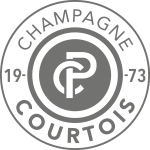History of Champagne COURTOIS
Maison familiale créée en 1971
ORIGINE
Our first vintage was born in 1973. We are located in Crouttes-sur-Marne, the first village in the Marne Valley, 70 kilometers east of Paris. From the very beginning, our parents chose to be artisan winegrowers. All stages of creating our vintages are carried out on the estate, thereby preserving the expression of our terroir and imprinting each vintage with our signature.
Fresh, sensual, elegant and gourmet, each vintage will charm amateurs and connoisseurs...
TERROIR
Our various plots are located across three municipalities: Crouttes-sur-Marne, which represents 68% of our area, Charly-sur-Marne 12%, and Villiers-Saint-Denis 20%. The heart of our winemaking is in our cellar in Crouttes-sur-Marne, with the furthest plot being only 2 kilometers away from it.
In the western part of the Marne Valley, the subsoil of the hillsides consists of clay-limestone (Marl) subsoil, which contributes body, length, and liveliness to our wines. However, at the bottom of the slopes between the villages of Crouttes-sur-Marne and Charly-sur-Marne, the subsoil is mainly composed of sand, providing fluidity and lightness to our wines.
The blend of our wines from these different plots reflects the terroir of our beautiful region.
ÉLEVAGE DES VINS
Pressing is carried out using a 6000 kg pneumatic press.
Following the harvest, our wines are aged in stainless steel vats for approximately 8 months.
We let the malolactic fermentation take place naturally. Then bottling takes place, generally during the spring period following the last harvest.
Our vintages then take the time to age quietly on slats before marketing for between 4 and 7 years depending on the vintage.
It is only after this time of aging in the cellar that we finish our wines, the moment of disgorging has arrived, that is to say the dosage which determines our champagnes as extra-brut, brut or demi-sec .
The dosage liqueur, also called “expedition liqueur”, is most often composed of cane sugar dissolved in wine at a rate of 500 to 750 g/l. The quantity of liqueur used for the dosage depends on the type of wine you want to obtain:
- Doux more than 50 grams of sugar per liter
- Demi-sec between 32 and 50 grams of sugar per liter
- Sec between 17 and 32 grams of sugar per liter
- Extra dry between 12 and 17 grams of sugar per liter
- Brut less than 12 grams of sugar per liter
- Extra brut between 0 and 6 grams of sugar per liter
For a content of less than 3 grams and if the wine has not had any added sugar, the words « brut nature », « pas dosé » ou « dosage zéro ».




